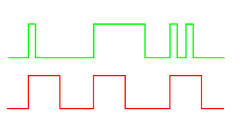Engineering:Monostable multivibrator

A monostable multivibrator, also called a one shot or a monoflop, is a sequential logic electronic circuit that generates an output pulse. When triggered, a pulse of pre-defined duration is produced. The circuit then returns to its stable state and produces no more output until triggered again.
Monostables may be considered as a biased form of multivibrator where it is stable in one state until triggered, then unstable and will return spontaneously.
If repeated application of the input pulse maintains the circuit in the unstable state, it is called a retriggerable monostable. If further trigger pulses do not affect the period, the circuit is a non-retriggerable monostable.
Circuit
In the monostable multivibrator, the one resistive-capacitive network (C2-R3 in figure 1 of multivibrator) is replaced by a resistive network (just a resistor). The circuit can be thought as a 1/2 astable multivibrator. Q2 collector voltage is the output of the circuit (in contrast to the astable circuit, it has a perfect square waveform since the output is not loaded by the capacitor).
When triggered by an input pulse, a monostable multivibrator will switch to its unstable position for a period of time, and then return to its stable state. The time period monostable multivibrator remains in unstable state is given by t = ln(2)R2C1.
For the circuit shown, in the stable state, Q1 is turned off and Q2 is turned on. It is triggered by zero or negative input signal applied to Q2 base. As a result, the circuit goes in state 1 described above. After elapsing the time, it returns to its stable initial state. This behavior is retriggerable: the output will stay high as long as the input is active, and then remain high for the relaxation period starting when the input is released.
It can also be triggered by applying a positive input signal through a resistor to Q1 base, though this method is non-retriggerable: the output will always stay high for the same period of time and then return to low, regardless of whether the input has been released.
See also
- Bistable multivibrator
- Astable multivibrator


